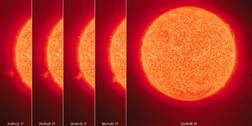|
The Sun is a yellow dwarf star, like most stars in the Milky Way. It appeared approximately 4.6 billion years ago and if all everything goes well, it will shine for another 5 billion years before becoming a red giant that, because of its temperature on that era, will finish with every single human being on Earth.
SOHO images

http://grin.hq.nasa.gov/IMAGES/SMALL/GPN-2002-000120.jpg
Temperature varies between 5500 °C at the surface, going for about 1 million degrees Celsius in the crown, to 15 million degrees Celsius at its core.

http://www.baixaki.com.br/papel-de-parede/8276-sol-vermelho.htm#seusite
The sun has a diameter of approximately 109 times the diameter of Earth. It has 333 000 times more mass than the Earth. Therefore, our weight in the sun would be 28 times greater than on Earth. It is composed primarily of hydrogen (92.1%) and Helium (7.8%).
Some data from the Sun:
Distance from the earth: 1496 × 10¹¹ m = 500 light-seconds.
Volume: 1,41 × 1027 m³
Mass: 1,9891 × 10³º kg
Diameter: 1.392.000 km
Density: 1,411kg/m³
Structure of the Sun
Solar core
• The core of the sun is about 1/5 of the solar radius.
• It is the warmest place of the sun, with about 15 million Kelvin.
• Energy is produced by nuclear fusion.
Area of radiation
• The energy produced in the nucleus migrates to this area.
• It takes about 171,000 years for energy to the core area of radiation.
• The area of radiation is between the core and the convection zone.
Area of convection
• The area of convection of a star is one in which energy is transported mainly by convection.
• A stellar convection is the movement of plasma (ions formed by field) where the most heated plasma is directed out of the star, while the less heated plasma is directed inwards.
• The convection occurs, for example, a liquid boiling in a pot or in the formation of sea and land breezes.
Solar Atmosphere
Corona
• The corona is a kind of "atmosphere" of the Sun
• Easily seen during a total solar eclipse,
• It is the most external part of the Sun
Photosphere
• The photosphere of an astronomical object is the region that receives light. It extends into the surface of a star until the gas becomes opaque.
Chromosphere
• The chromosphere (literally, "color sphere") is a thin layer of the atmosphere of the Sun above the photosphere.
• Nearly 10 thousand kilometers of depth
• The chromosphere is more visually transparent than the photosphere.
• The name comes from the fact that it has a reddish color (dominated by dark red).
Transition Region
• The region of transition is between the chromosphere and corona.
• It is visible from space by using telescopes with UV sensor.
• It is important because it is the place of several, but important physical transitions of solar atmosphere.
Solar Radiation
• Solar radiation is the energy resulting from nuclear explosions.
• The amount of radiation absorbed by the Earth depends entirely on the distance between him and the star.
• When this radiation is absorbed without protection, problems such as skin cancer can happen.
• Each region of the Earth receives a given quantity of radiation depending on the slope.
|



